Fun with Magnets
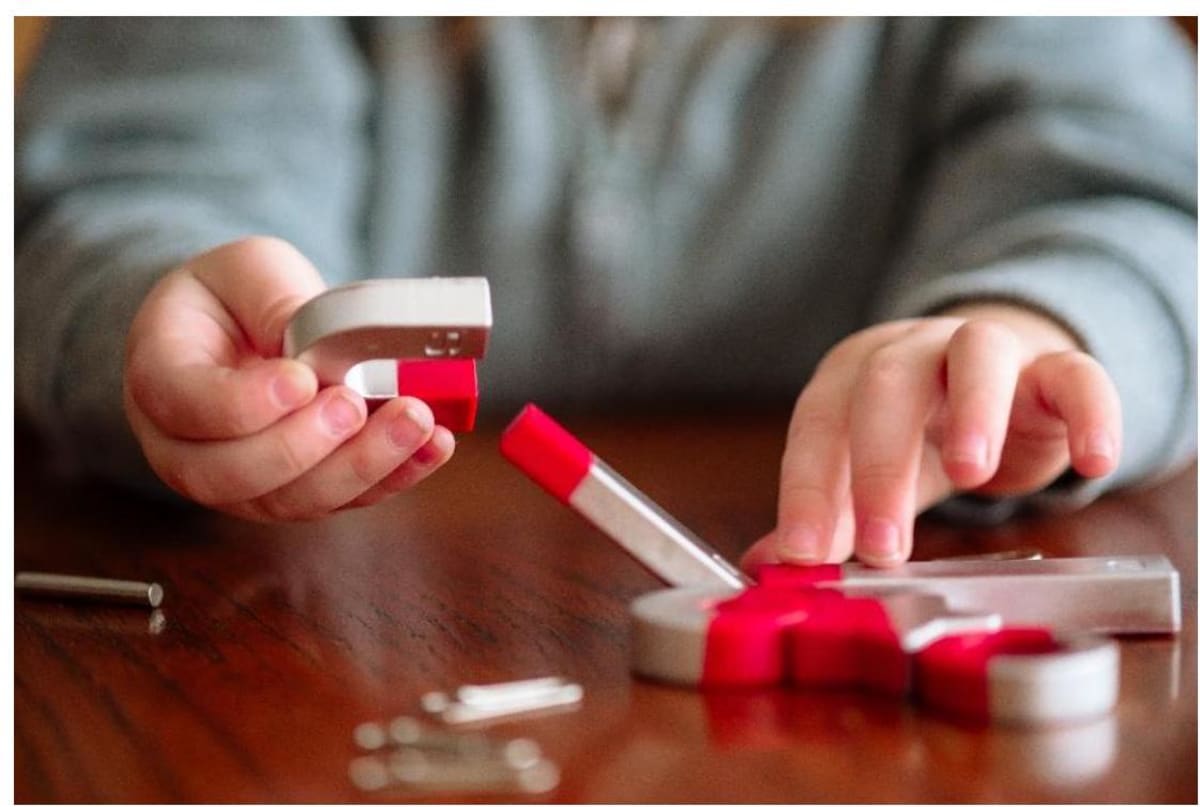
1.0Introduction
It is said that, there was a shepherd named Magnes, who lived in ancient Greece. He used to take his herd of sheep and goats to the nearby mountains for grazing. He would take a stick with him to control his herd. The stick had a small piece of iron attached at one end. One day he was surprised to find that he had to pull hard to free his stick from a rock on the mountainside. It seemed as if the stick was being attracted by the rock.
The rock was a natural magnet and it attracted the iron tip of the shepherd's stick. It is said that this is how natural magnets was discovered. Such rocks were given the name magnetite, perhaps after the name of that shepherd. Magnetite contains iron. It is also known as lodestone.
Some people believe that magnetite was first discovered at a place called Magnesia. The island of Magnesia is situated in west of present day Turkey. Chinese also used magnetic needles for navigation on ships as early in 400 B.C.
2.0What is a magnet?
You may have played with magnets and watched them snap together or push apart. Magnets can also make some objects move or even fly through the air. A magnet can affect an object without even touching it.
The substances having the property of attracting magnetic materials like iron are now known as magnets.
When you bring two magnets close together, they will either repel or attract each other. The force that pushes magnets apart or pulls them together is called magnetic force. In other words 'a magnet is any object with magnetic force'.
Natural magnets
Naturally occurring minerals or ores having magnetic properties are called 'natural magnets'. Due to their irregular shapes and weak attracting power, natural magnets are rarely used now a days.
Artificial magnets
Now a days pieces of iron and many other materials of suitable shapes and sizes are made as magnets. Such magnets are called artificial magnets. e.g. Bar magnet, U-shaped magnet (horse-shoe magnet), cylindrical magnet or a ball ended magnet, magnetic compass needle, etc.
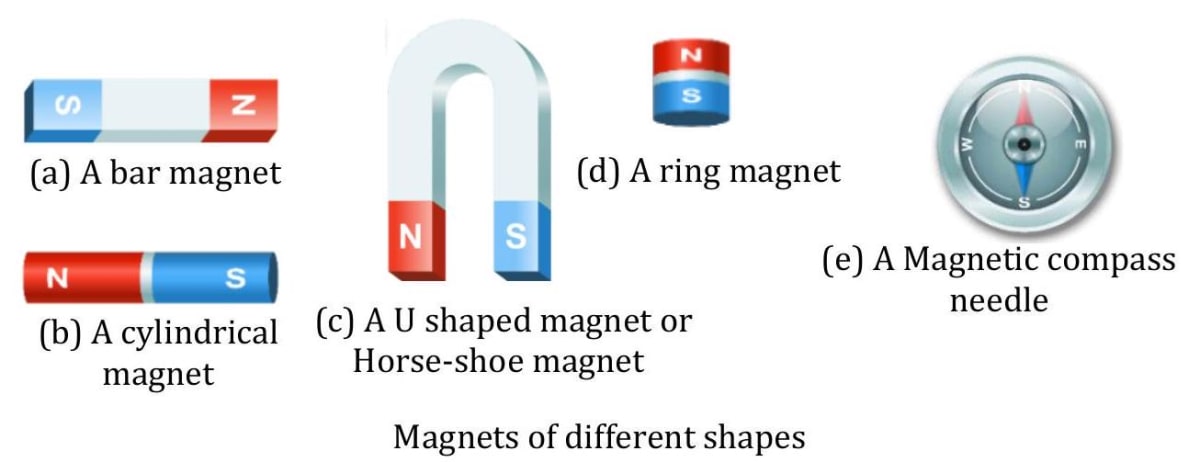
3.0Magnetic and non-magnetic materials
The magnet attracts certain materials whereas some do not get attracted towards magnet. The materials which get attracted towards a magnet are called magnetic materials. Iron, nickel and cobalt are magnetic in nature.
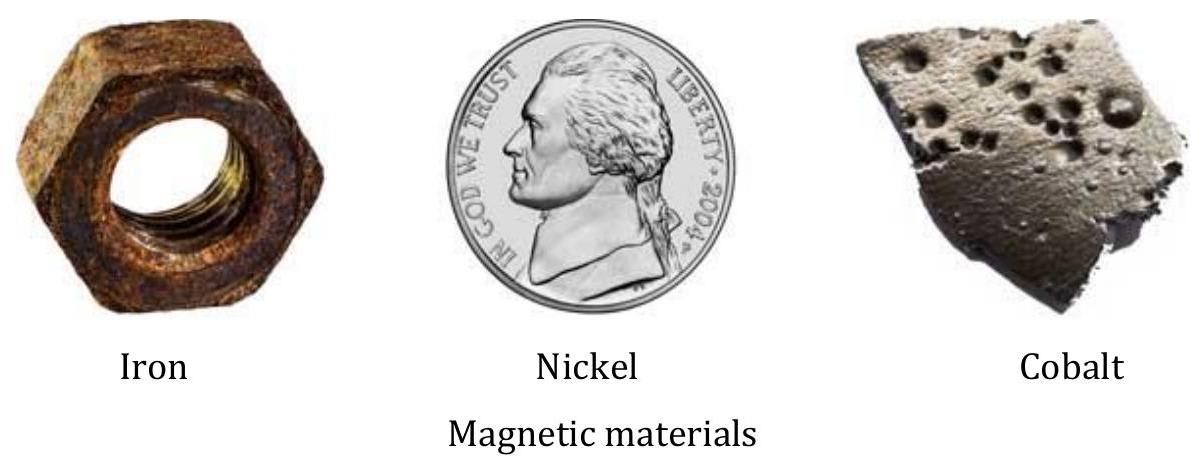
The materials which do not get attracted towards a magnet are called non-magnetic materials. Most of the materials we use in our daily life are non-magnetic in nature. Copper, aluminium, silver, wood, plastics, rubber, paper, etc. all are non-magnetic in nature.
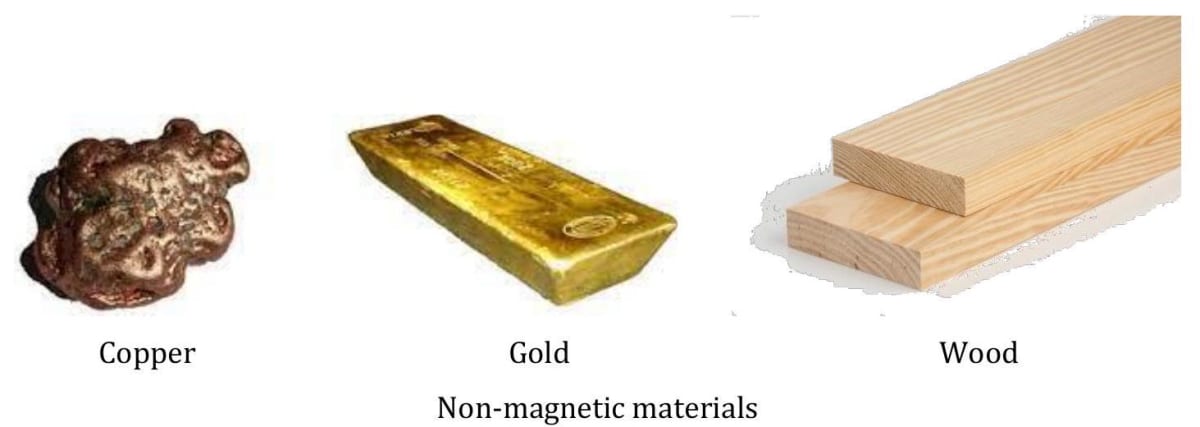
If an object attracts to both poles a magnet, it is surely a magnetic material.
4.0Magnetic poles
The parts of a magnet where the magnetic force is strongest are called the magnetic poles. All known magnets have two poles, a north pole and a south pole.
5.0Properties of a magnet
Attractive nature
When iron filings are put near a bar magnet, the magnet attracts iron filings towards it. The attracting power is maximum (see figure) near the ends (poles) and minimum at the middle (neutral region).
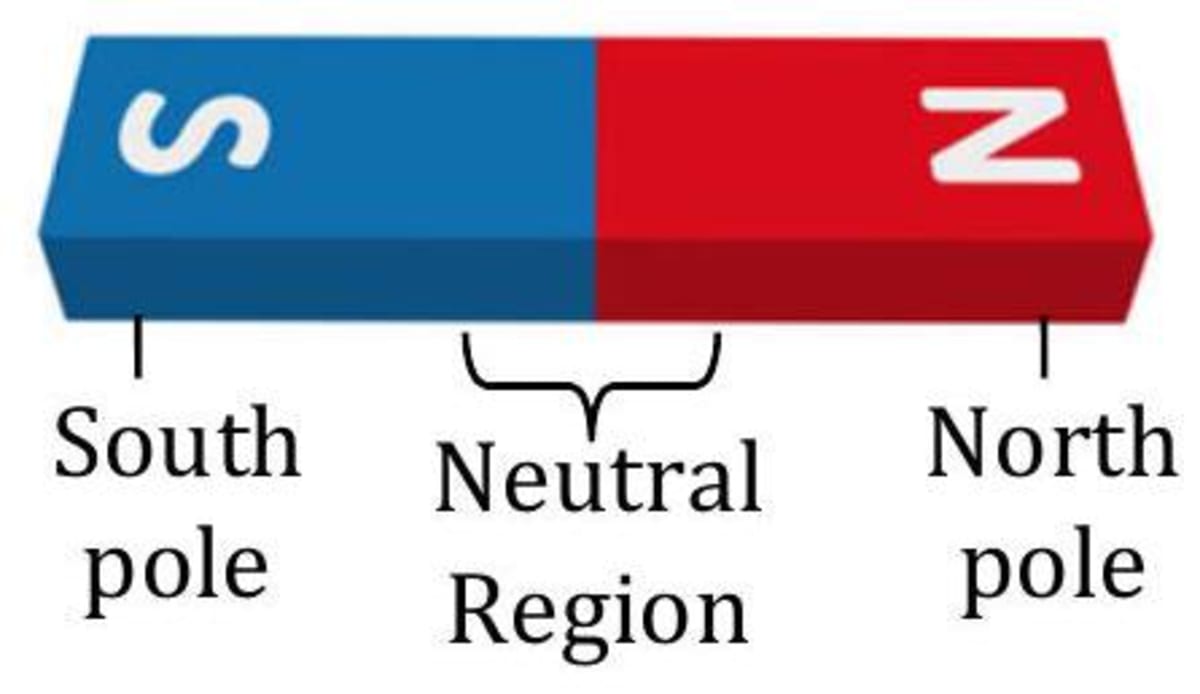
Directive property
When a magnet is suspended freely, it aligns itself to north-south direction. The pole of the bar magnet pointing towards north direction when suspended freely is called 'north pole (or north seeking pole)'. The pole of the bar magnet pointing towards south direction when suspended freely is called 'south pole (or south seeking pole)'.
- To find directions using a magnet you should have knowledge about the properties of magnet like magnet aligns itself in north south direction when suspended freely.
Poles exist in pairs
In a bar magnet, there are always two poles which are equal in strength and opposite in nature. In other words, 'a magnet is always a dipole'.
- Repulsion is a sure test to find a magnet.
Inductive nature
When certain substances like iron, steel, cobalt, nickel are placed near a bar magnet, they acquire magnetisation called 'induced magnetisation'. The phenomenon is called 'magnetic induction'. It involves inducing opposite pole in a magnetic material like iron on the side facing the magnetic pole (see figure).
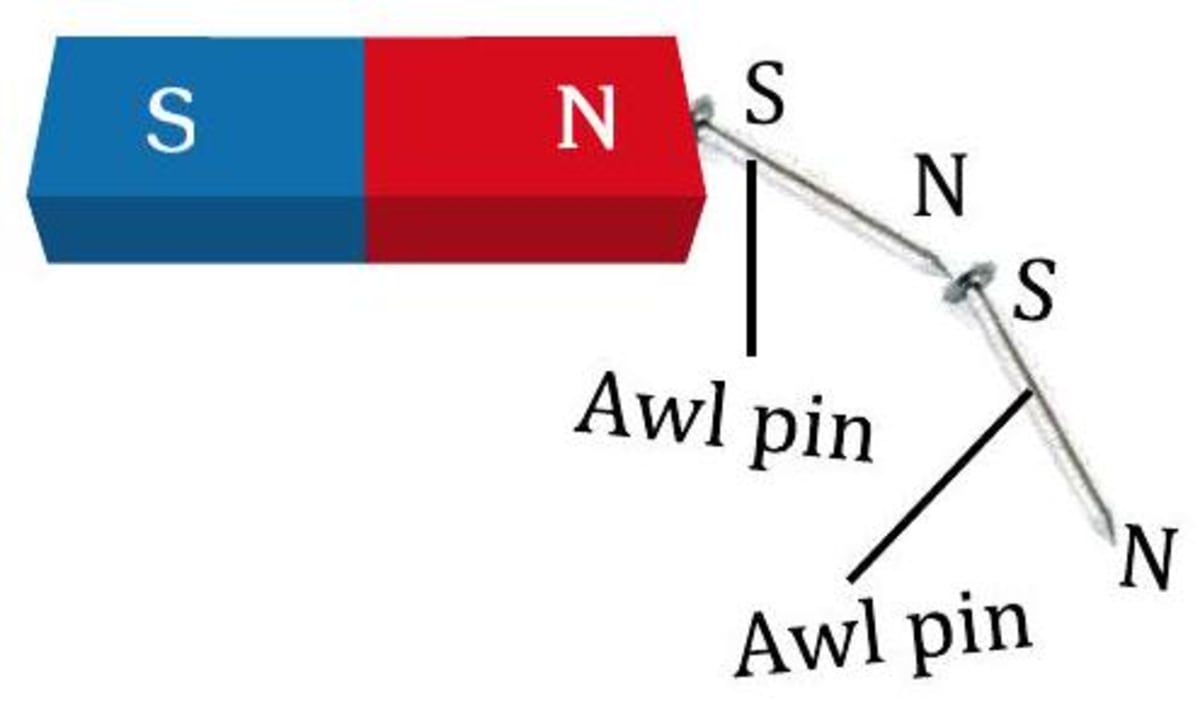
Forces between the poles of two magnets
When two magnets are brought together, a north pole and a south pole attract each other i.e., unlike poles attract each other [see figure (a)]. Like poles (north-north or south-south) repel each other [see figure (b)].


- Hammering or heating a magnet will cause it to loose its magnetism as by this the molecules lose their north south alignment and get arrange in random direction.
6.0Magnetic field
A region of influence surrounding a magnet, in which other magnets or materials like iron are affected by magnetic forces is called 'magnetic field'.
7.0Finding direction using magnets
Magnets were known to people from ancient times. Many properties of the magnets were also known to them. It is said that an emperor in China named Hoang Ti had a chariot with a statue of a lady that could rotate in any direction. It had an extended arm as if it was showing the way (see figure). The statue had an interesting property. It would rest in such a position that its extended arm always pointed towards South.
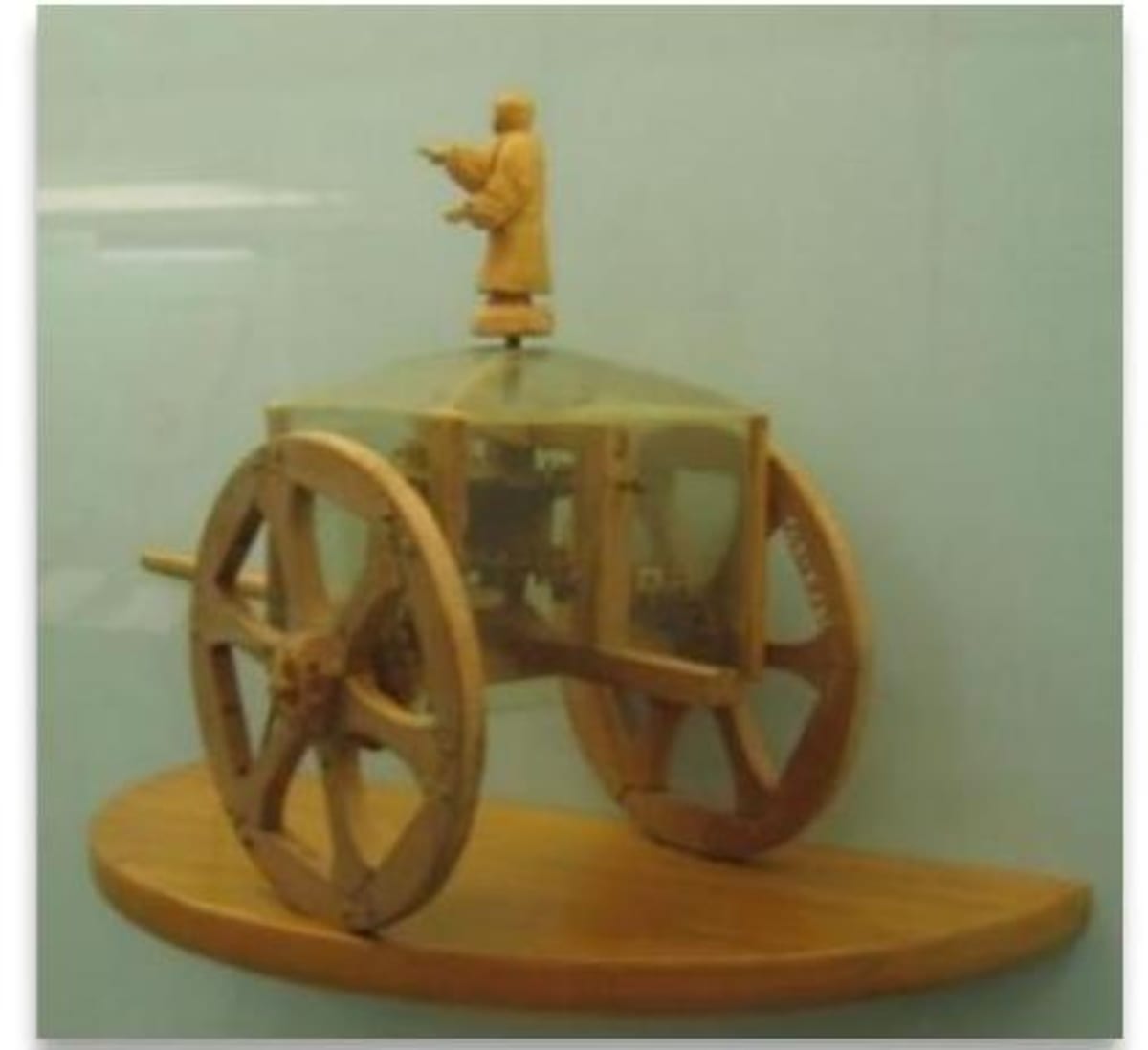
The chariot with direction finding statue
By looking at the extended arm of the statue, the Emperor was able to locate directions when he went to new places on his chariot. The property of magnet that was used in statue of the lady is that, 'a freely suspended magnet always keeps itself in north-south direction'.
- Earth's magnetic field is 1000 times weaker than a typical bar magnet.
Magnetic compass needle (or compass)
Pretend you are on a boat at night. No land is in sight. The sky is cloudy. Ancient sailors could become lost on such nights until the compass was invented.
- A magnetic compass needle or simply 'compass' is an instrument that uses Earth's magnetic field to help people find directions (see figure). A compass needle is actually a thin magnet. The needle points in north direction because it aligns in the direction of Earth's magnetic field. Since a compass needle points north, the compass can be used to tell north, east, south, and west, and other directions in between.
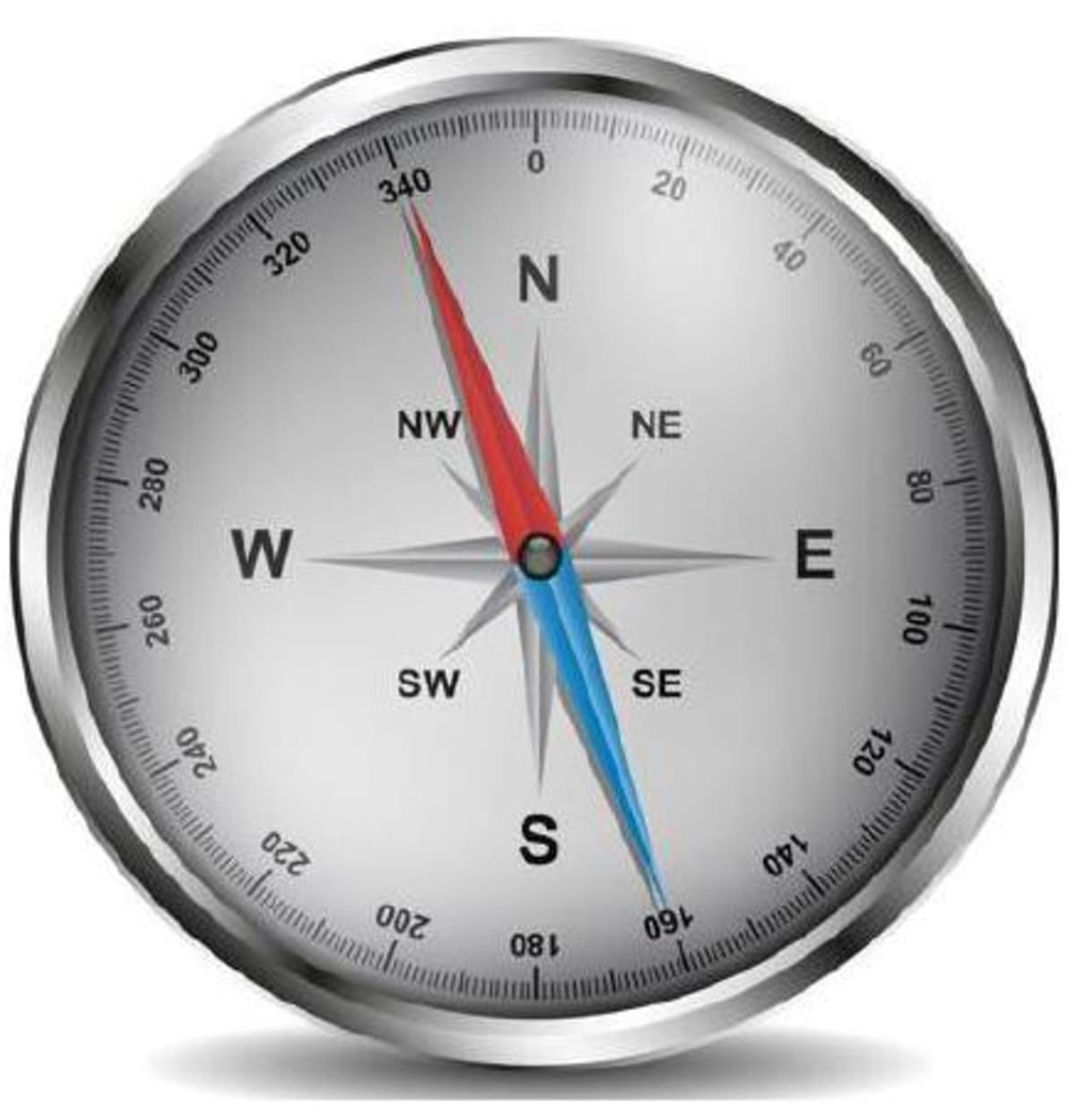
A magnetic compass needle
- A magnetic compass needle approximately point toward Earth's north pole. The geographic north pole and the magnetic north pole are in slightly different places.
- If any strong magnetic field is near a compass, its's needle will align along its magnetic field and not the earth's magnetic field.
8.0Electromagnets
In the 1820s and 1830s, scientists such as Michael Faraday and Joseph Henry made some amazing discoveries about electric currents and magnets. They found that electric currents make magnetic fields and that magnets could generate, or make an electric current. When an electric current flows through a wire, it creates a magnetic field around the wire. Increasing the current makes the magnetic field stronger. You can also make the magnetic field stronger by winding the wire into a long coil. Each loop of wire is like a little magnet that has its own magnetic force. All loops together produce a strong magnetic field. An electromagnet is a coil of wire wrapped around an iron core. When an electric current flows through the coil, it creates a magnetic field. This produces temporary magnetism in the iron core. Thus, magnetism of current carrying coil and iron core together produces a strong magnetic field. When the current stops, the iron core is no longer magnetised and there is no magnetic field due to the coil.
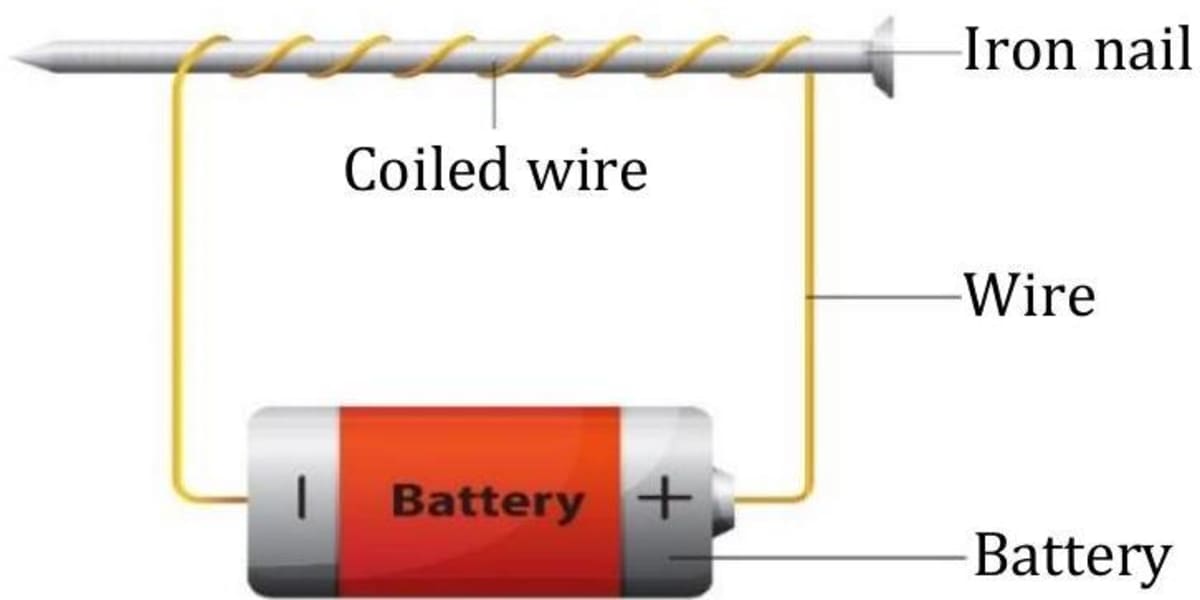
Advantage of electromagnet over permanent magnet
(i) An electromagnet can produce a strong magnetic field as compared to a permanent magnet. (ii) The strength of a magnetic field of an electromagnet can be changed easily by changing the current or the number of turns in the coil. (iii) The polarity (north pole or south pole) of the electromagnet can be changed by reversing the direction of the current. (iv) An electromagnet can be easily magnetised or demagnetised as per the requirement.
Electric bell
In an electric bell, a small hammer is attached to the iron strip called armature. The armature is vibrated back and forth several times a second, striking a metal bell (or gong). Figure shows the circuit that causes the armature to move. When a button is pushed, the switch is closed. An electric current flows through the contact and the spring attached to the coil, and the iron core become magnetised. The core attracts the iron armature, which moves toward the electromagnet, causing the hammer to strike the bell. As the hammer strikes the bell, the movement of the armature opens the contact. The electric current stops flowing to the coil and the soft iron core becomes demagnetised, releasing the armature. A spring pulls the armature back to re-establish contact, thereby completing the circuit, and the entire cycle begins again.
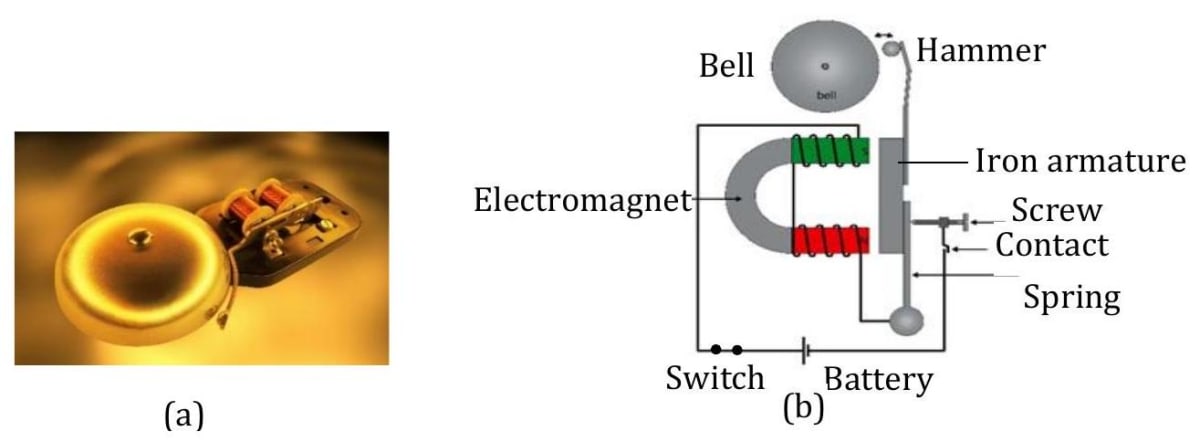
Uses of magnets and electromagnets
(1) They are used in radio and stereo speakers. (2) They are used in almirah and refrigerator doors to keep them in closed position. (3) They are used on video and audio cassette tapes. (4) They are used on the hard discs and floppies for computers.
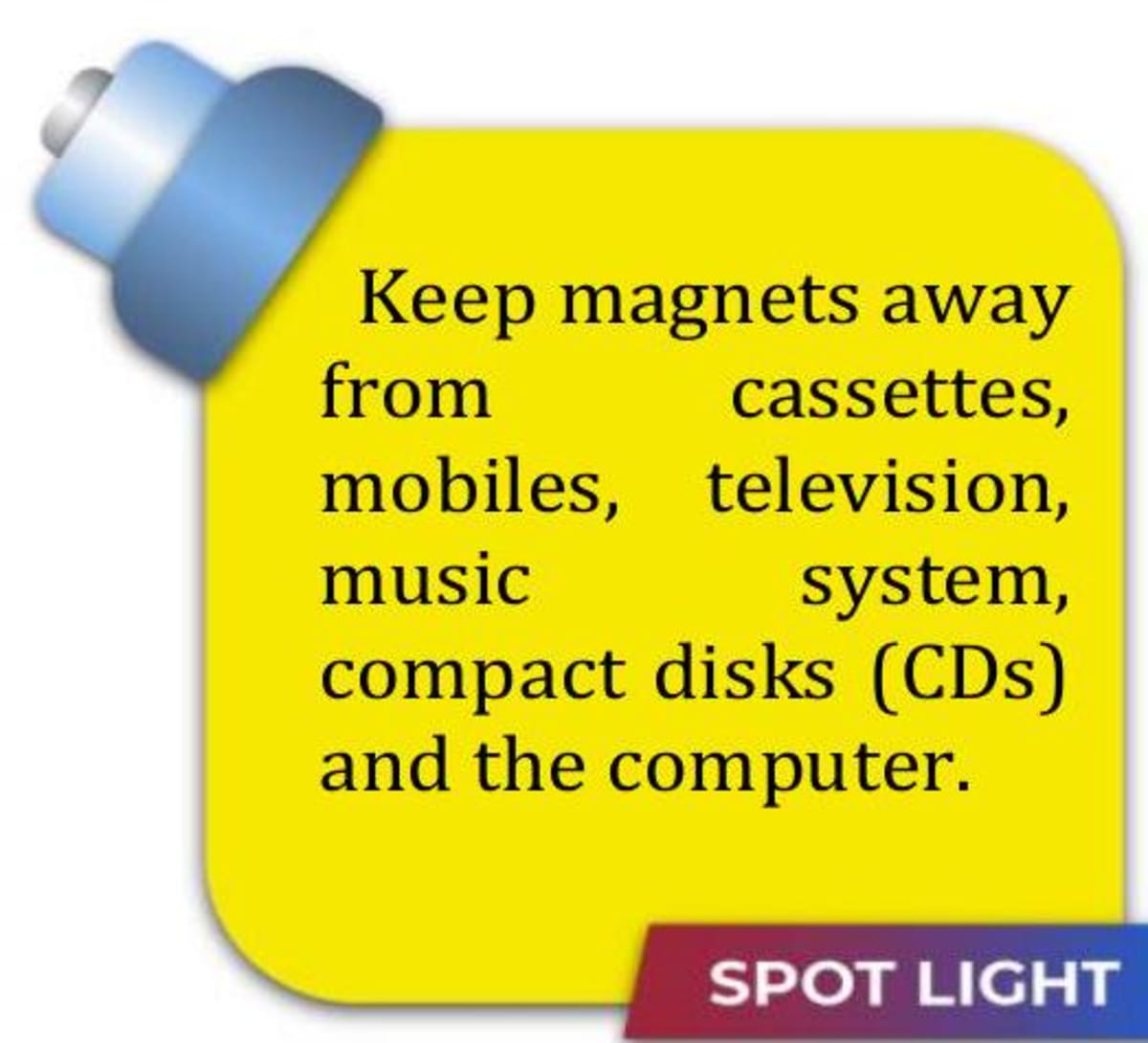
9.0Safety measures for magnets
(i) Magnets should not be heated at high temperatures, repeatedly hammered or dropped from some height. This is because by doing so, they loose their magnetism. (ii) Keep magnets away from the cassettes, mobiles, television, music system, compact disks (CDs) and the computer. (iii) Magnets become weak if they are not stored properly. Magnets tend to become weaker after some time if their poles are left free. This is called self demagnetisation. To avoid this, bar magnets are kept in pairs separated by a piece of wood, with unlike poles on the same side. Pieces of iron, called magnetic keepers or simply keepers, are placed across both the ends. A horseshoe magnet needs only one keeper across its poles.

10.0Concept Map
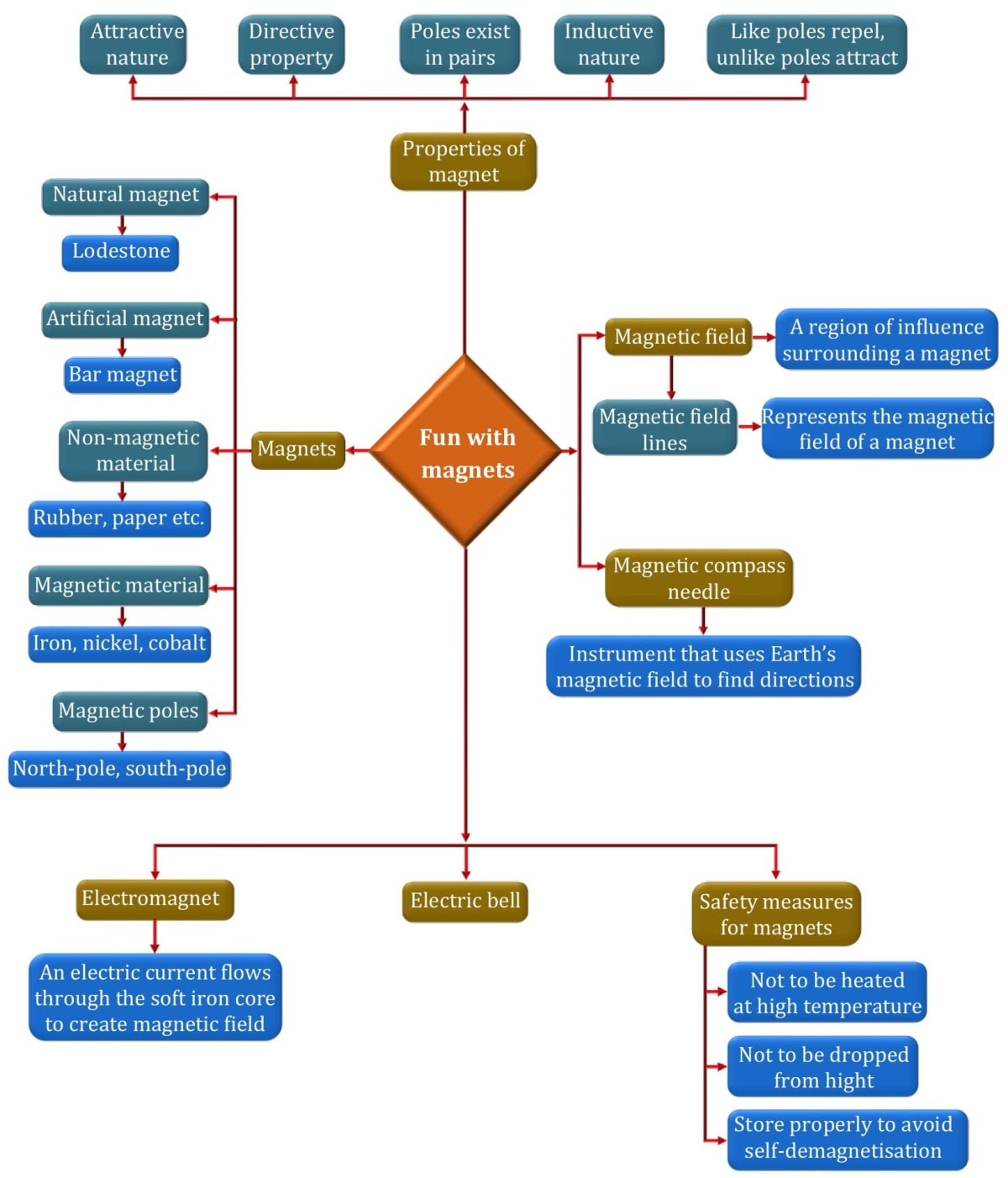
- A magnet is kept quite close to a gold ring, but the ring did not get attracted towards the magnet. Try to find out the reason behind it.
- First thing that should come in your mind is that 'a magnet always attract a magnetic material, it does not attract a non-magnetic material'. This means gold is a non-magnetic material.
- A freely suspended magnet aligns in a north-south direction. Why ?
- Earth has its own magnetism, similar to the magnetism of a bar magnet. The poles of the giant imaginary magnet inside the Earth are located near, but not exactly at, Earth’s geographic poles. This is why, a freely suspended magnet align itself to Earth’s magnetic north and south poles. Actually, a freely suspended magnet aligns approximately not exactly in the geographic north-south direction.
- Can we separate the north pole of a magnet from its south pole by breaking it from the middle ?
- If we break a magnet into two parts from the middle, we cannot isolate the north and the south poles. Instead we will get with two separate magnets, each with its own north and south poles. If we further cut these two magnets, we would get four separate magnets, each with its own north and south poles (see figure). This means, poles always exist in pairs, and we can never have an isolated north pole or south pole.
11.0Some basic terms
- Suspended - supported by attachment from above.
- Align - Place or arrange in a straight line.
- Grazing - to feed on growing grass or to eat grass.
- Ores- a naturally occurring mineral containing a valuable constituent (such as metal) for which it is mined and worked.
- Impurities - substances that are present in small quantities in another substance and make it dirty or of an unacceptable quality.
- Chariot - a small carriage pulled by horses.
- Coil - consists of a core and a wire wound around the core.
- Gong - a large, flat, circular piece of metal that you hit with a hammer to make a sound like a loud bell.
- Armature - a piece of soft iron or steel that connects the poles of a magnet or of adjacent magnets.
- Keepers - a piece of wood or soft iron which is used in storing magnets because bar magnets get demagnetised.
Related Article:-
Join ALLEN!
(Session 2026 - 27)